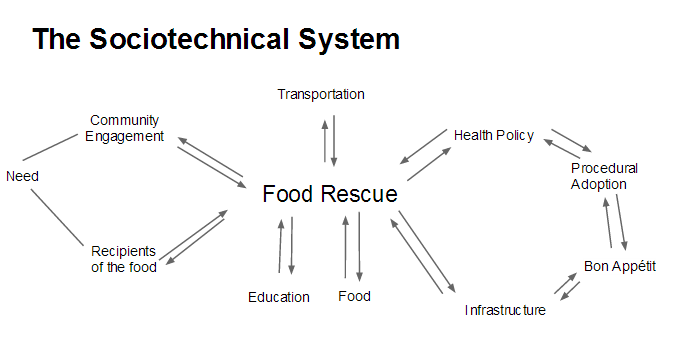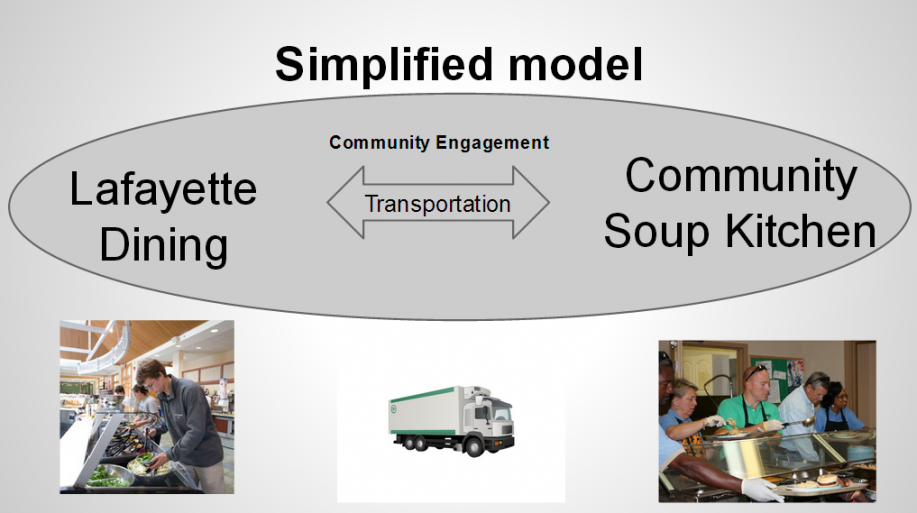Conclusion
What have we learned?
Our research question was “What would it take to implement a food rescue program at Lafayette?”. We explored this question in four contexts in great detail: the social context, the political context, the technical context, and the economic context. This gave us the broad perspective this problem needed to fully understand.
Social Context
Our main conclusion from our study of the social context of a food rescue program at Lafayette college is that it is socially feasible for food rescue program to be implemented within Lafayette community. The city of Easton has a large need for such a program and Lafayette has resources to aid hunger within this area. In particular, the recently formed Huger Coalition of Easton is great evidence of the community efforts being made to fill this hunger gap and link resources to need. n a recent meeting held at Lafayette College, we discovered that the Hunger Coalition would be very interested in assisting in the development of a Lafayette college food rescue program. Also Lafayette College is a liberal-arts college that prides itself on community engagement. A food rescue program is a great way for Lafayette to take into account its role and actions in this community and be involved in a discussion it may no have been before. The food rescue program would be a way for Lafayette to reduce food waste, increase community involvement, and raise awareness to a bigger problem of hunger and food waste on a national level.
Policy Analysis
Our main conclusion from our policy analysis is that it is politically feasible to implement a food rescue program at Lafayette. The stakeholders involved with the implementation of a food rescue program are Bon Appétit, the Lafayette Administration, the Lafayette student body, the Easton community, and a food collection agency. Through various conversations and research we have been able to verify the interest in such a program from Bon Appétit and the Easton community. We have also verified that there are food collection agencies within the area capable of receiving the food. The only stakeholders we have not been able to verify an interest from is the Lafayette student body and the Lafayette administration (see What are the next steps?).
We also learned about the legal issues associated with food recovery. Our findings were that in general there are no legal issues with donating food. There are laws in place both on the federal and state level to protect both Bon Appétit and the food collection agency with good faith food donations. And according to a new report from the University of Arkansas Food Recovery Project, there has never been a single lawsuit regarding liability of donated food. Therefore other than any college policies regarding students in the kitchen, we do not foresee any policy related issues to obstruct the implementation of a food rescue project.
Technical Context
Although the complete technical context could not be developed, in general Lafayette has the capability to implement a food rescue program within the community. We were able discuss with Bon Appétit’s waste specialist Claire Cummings about 2 basic models other Bon Appétit colleges have followed. The two models include: a student-run model (typically through the Food Recovery Network) and a direct model. Both models have their merit but we believe given the resources of the community, a student-run model would be ideal. This model would provide more support for the program and would aid in Lafayette’s community engagement efforts.
The picture above shows what the technical system would look like. What this model is missing is the actual scheduling, labor force, transportation source, and materials needed to actually work.
Economic Context
The general understanding of the economic costs in a food recovery system is that the most costly aspects will result from the transportation and storage of food. Because the people helping to actually run the program will likely be volunteers or paid through a non-profit organization, labor costs would not be incurred by Lafayette College. Long term solutions for the transportation and storage of food will be necessary for a sustainable future to this program. As noted in the Denison case study, buying disposable pans can prove to be costly. Instead a further investigation into investing in reusable pans is advised.
Overall Conclusion
Bringing all together from each aspect of the project, we learned that it is feasible to develop a food rescue program at Lafayette College. Everything necessary for implementing a food rescue program exists pertaining to Lafayette College. The need of the Easton community is apparent and organizations such as the Hunger Coalition can act as the community voice. The stakeholders involved in a Lafayette College food rescue program have the capability and interest of implementing a program. Most importantly Bon Appetit has the experience and interest in implementing a program. The Food Recovery Network is growing and thriving at college’s and universities across the nations including 25 Bon Appetit schools. Technically,the storage capacity of Lafayette dining would support a food rescue program. Transportation can be provided by students or the local agency in their own vehicles or Lafayette College can allow for the use of mini-vans. The direct expenditures of the program only include the cost of trays for transport and the cost of gasoline, both of which are relatively low.
Our study determined the variables we identified in our sociotechnical system (seen below) all exist and support the implementation of a food rescue program. However there are challenges and steps that must be taken for food rescue to become a reality at Lafayette College.

What are the next steps?
A food rescue program at Lafayette is possible with the right resources. As outlined in this site, the limitations to successfully starting food rescue projects nationally and at Lafayette are economic, social, technical and political (hence the format of the site). While lofty, there are only a few specific aspects that need to be addressed before Lafayette can get a program off the ground.
There are a few critical meetings that have yet to take place. Stephen Schafer, Controller and Associate Vice President of Finance, will have keen insights on whether or not this is financially feasible as well as whether or not donating food represents an appropriate risk to the College. After this meeting and other pertinent conversations with Lafayette College administrators have been completed, it will be necessary to partner with a national organization such as the Food Recovery Network to help get food at Lafayette College effectively into an emergency food system. Organizations like this can often provide financial support for initial investment in equipment (such as pans).
Technological issues surround how to actually deliver and store food. From conversations with Joel Blice, it seems that refrigeration space is not an issue and there could be space devoted to this type of program. However, Dining Services would not be able to transport this food. This last technical challenge is a result of complex economic and political forces. Other technical issues that need addressing during the implementation of this project would be a direct community recipient. Second Harvest Food Bank is a potential recipient however, finding local soup kitchens and churches that could handle prepared food donations is an important step once a student infrastructure is created on Lafayette’s end.
This being said, the steps that will need to be taken lie mostly in economic and technical challenges. These challenges include ensuring a sustainable cohort of student volunteers to package and potentially transport food. This will most likely be achieved through the FRN chapter. Finding the correct partner for donations is critical since the success of the program depends on the partner’s ability to serve those in need. There is an exciting future for Food Rescue at Lafayette, with the right students to help carry this forward. This program will prove to only further strengthen the College’s relationship with our local communities and will help in the solution to the problem of food waste and hunger.
But for this project to have any of these it needs to be developed and implemented to the next level. In short, here is a list of what to do next:
1. Talk with Lafayette Administration
Talk with Stephen Schafer, Controller and Associate Vice President of Finance about costs on the college’s end and legal concerns of the college
2. Start a Food Recovery Network Chapter
A Sophomore or Junior student needs to act as the initiate to starting a food recovery chapter for continuity. Starting the chapter will provide resources for developing a student organization and costs of trays and transportation.
3. Find local agency
After the chapter is formed the contact from FRN will aid in partnering with a local food group. Also use the list of Easton hunger relief sites as a starting point.
4. Implement
Coordinate with Joel Blice, Claire Cummings, FRN, and the local agency to set up the logistics of the program.
Those who may utilize our findings will need the following contacts to help develop Lafayette’s food rescue program.
People to contact to continue growth of the project:
Joel Blice (General Manager, Bon Appetit Lafayette)
email: blicej@lafayette.edu
phone: 610-330-5346
Claire Cummings (Waste Specialist, Bon Appetit Management Company)
email: claire.cummings@BAMCO.com
Janet Ney (Second Harvest Food Bank)
email: jney@caclv.org
Office: 484-893-1106
Cell: 610-248-9902
Bonnie Winfield (Center for Community Engagement)
email: winfielb@lafayette.edu
phone: 610-330-5813
Food Recovery Network
to start a chapter
Lafayette College has the ability to implement a food rescue program. With the movement towards sustainability nationally and on Lafayette’s campus the current state of how Lafayette deals with its pre-consumer food waste is unacceptable. A food rescue program at Lafayette would act as a sustainable practice and part of the solution to some of the world’s most challenging problems (hunger and waste). It is time for Lafayette to join the growing initiative of college’s across the nation creating food rescue type programs. A Food Recovery Network Chapter is the best way for Lafayette’s program to get going. It is time for Lafayette to stop being part of the larger problem and start being part of a growing solution.


Leave a Reply